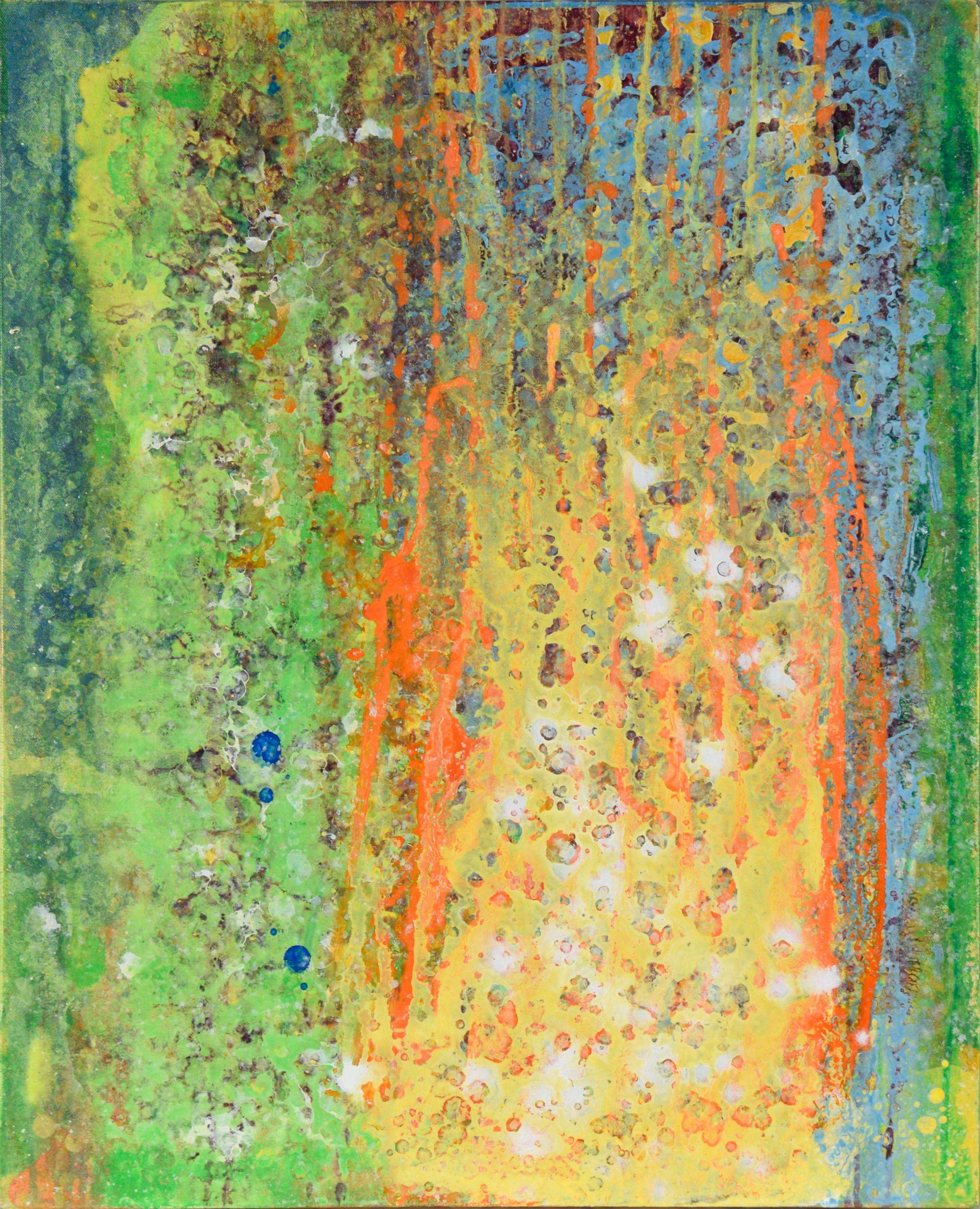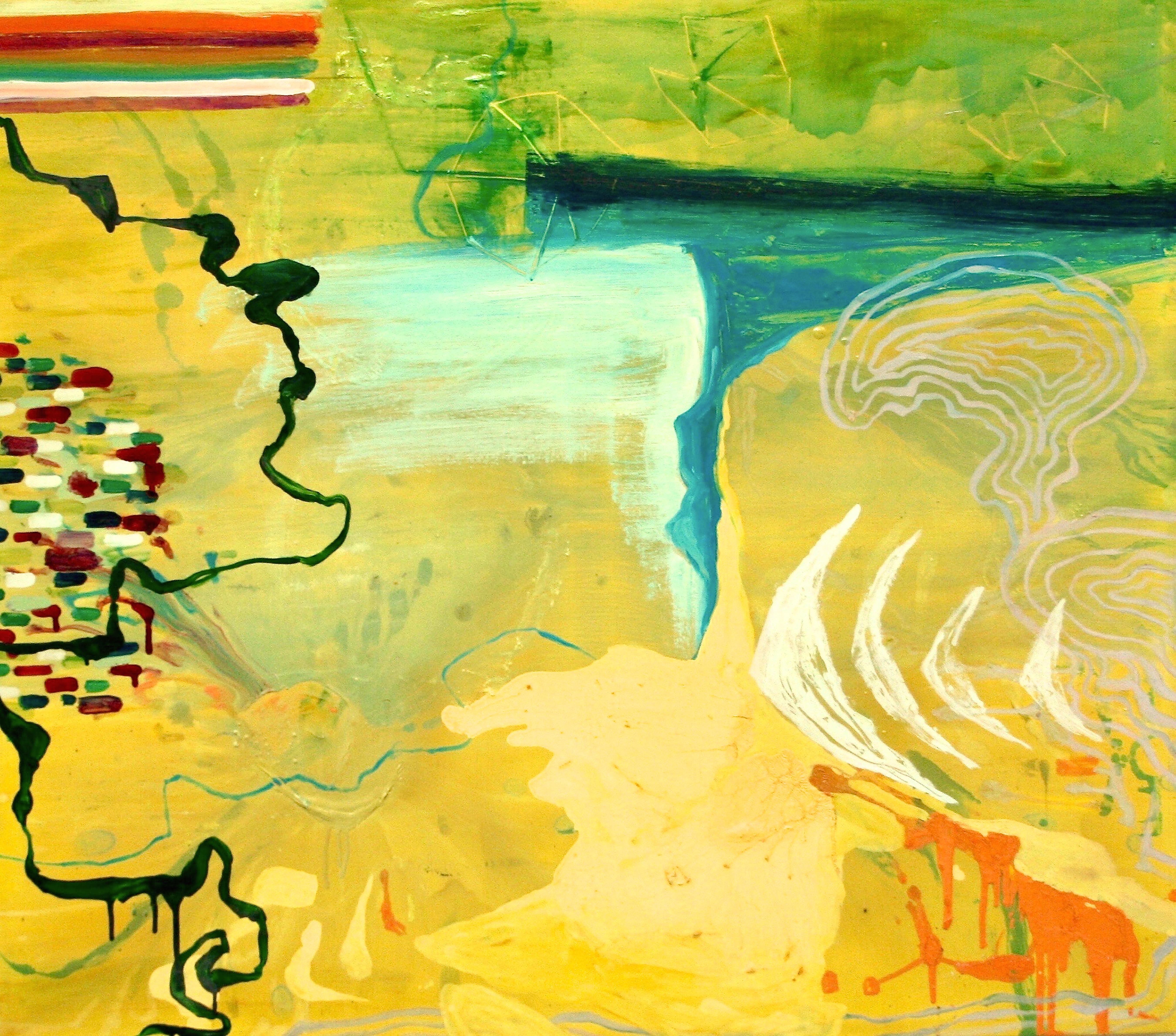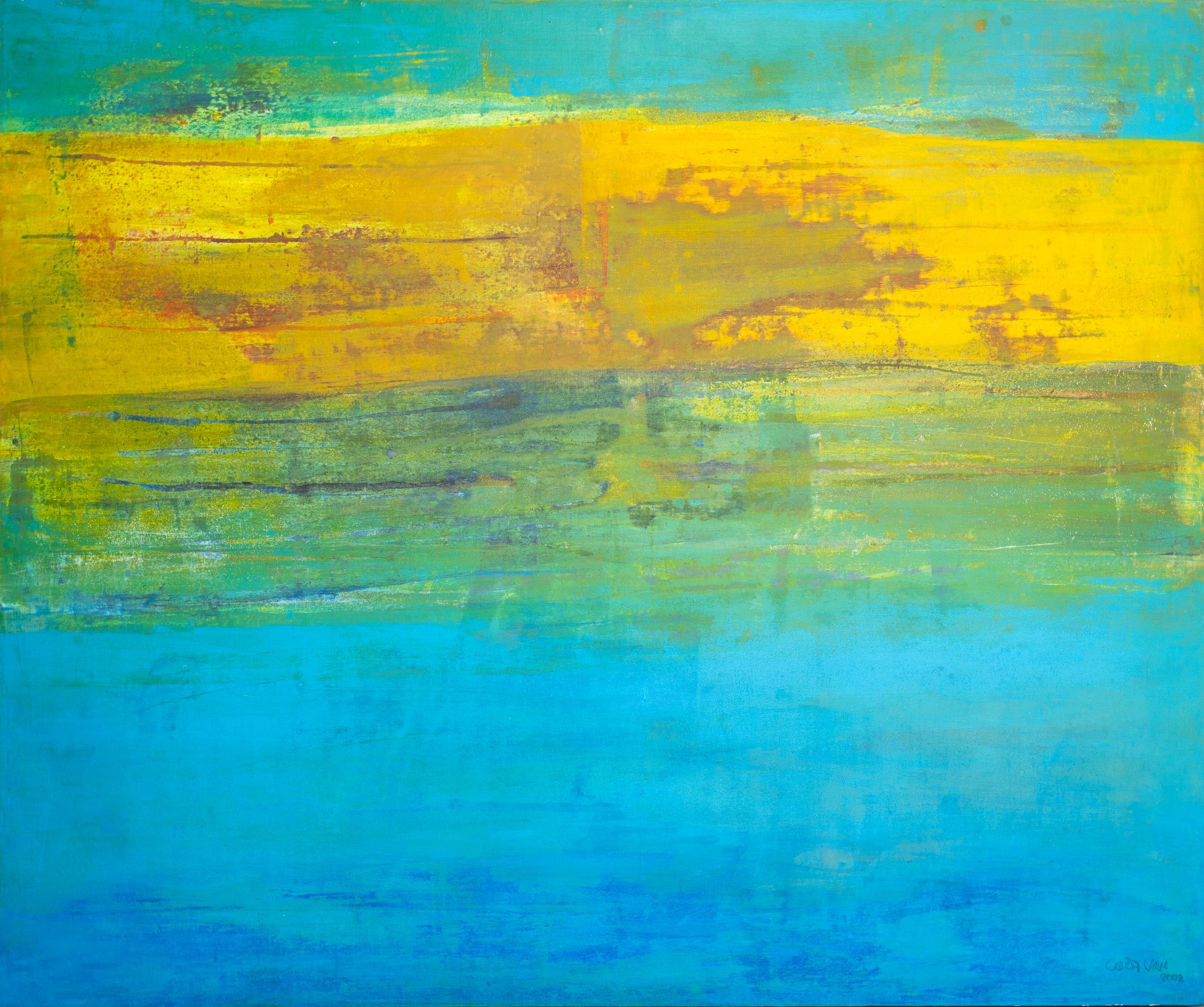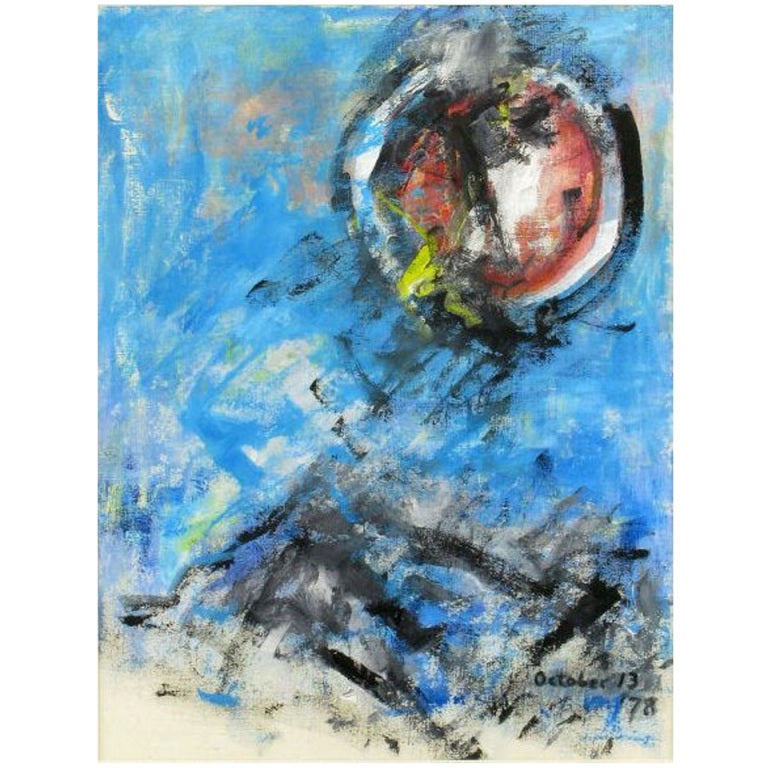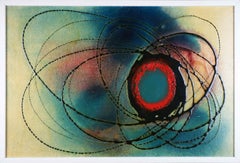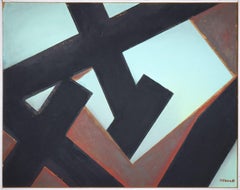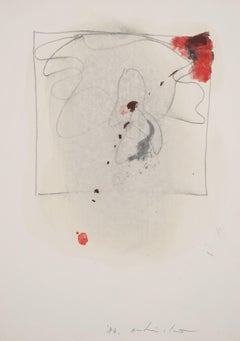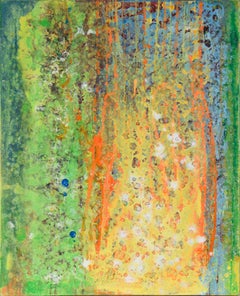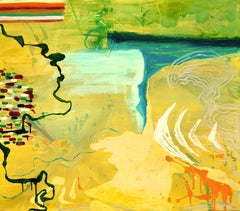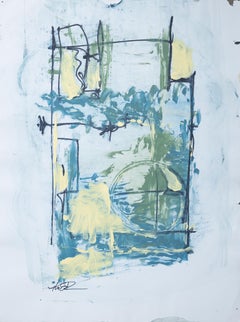Items Similar to Eccentric discharges of a turquoise-yellow core / - Energetic traces -
Want more images or videos?
Request additional images or videos from the seller
1 of 8
Eccentric discharges of a turquoise-yellow core / - Energetic traces -c. 1975
c. 1975
$614.41
$768.0120% Off
£465.90
£582.3720% Off
€520
€65020% Off
CA$864.89
CA$1,081.1120% Off
A$944.92
A$1,181.1520% Off
CHF 495.24
CHF 619.0420% Off
MX$11,282.63
MX$14,103.2920% Off
NOK 6,267.25
NOK 7,834.0620% Off
SEK 5,844.08
SEK 7,305.1020% Off
DKK 3,961.24
DKK 4,951.5520% Off
About the Item
Klaus Oldenburg (*1942 Berlin), Eccentric discharges of a turquoise-yellow core, around 1975. paint and cast resin on chipboard, 39 x 59 cm (inside dimension), 42 x 62 (frame), unsigned.
- isolated rubbed spots, otherwise in good condition
- Energetic traces -
About the artwork
Discharges emerge from a yellow energy core with a turquoise corona, reflected in black and red traces of colour. A snapshot that freezes the moment and at the same time is an ongoing processual movement. In this way, time itself is represented as a perpetual moment, which further enhances the dynamics of the image.
The synthetic resin used creates a glossy surface that literally seals the motif within itself. As a result, it does not appear to have been made by an artist's hand, but as something autonomous, fixed by a quasi-scientific process. The flow of the synthetic resin, which is reflected in the motif, also contributes to the effect of independence: The energetic discharges have found their adequate visible form in the flowing movements of the material. We seem to be witnessing an event in the atomic or subatomic world, which becomes present in the event of form and colour. Thus, the abstract art before our eyes is by no means purely abstract, but has a representational connotation and is a rare pictorial example of the Space Age.
About the artist
Born in Berlin, Klaus Oldenburg studied at the State School of Civil Engineering in Berlin from 1961 to 1964 and then worked as a civil engineer and architect until 1967. From 1967 to 1968 he ran the jazz club and artists' meeting place "Kilroy" in Berlin-Wilmersdorf, and then devoted himself entirely to art as a freelance painter. From 1968 to 1972 he had a studio in Berlin-Kreuzberg and from 1972 in Berlin-Friedenau. Since 1972, Oldenburg, who belonged to the Kreuzberg Bohemians, has shown his work at the Free Berlin Art Exhibition.
GERMAN VERSION
Klaus Oldenburg (*1942 Berlin), Exzentrische Entladungen eines türkis-gelben Kerns, um 1975. Farbe und Gießharz auf Spanplatte, 39 x 59 cm (Innenmaß), 42 x 62 (Rahmen), unsigniert.
- vereinzelte beriebene Stellen, sonst in gutem Zustand
- energetische Spuren -
zum Kunstwerk
Aus einem gelben Energiekern mit türkiser Corona emergieren Entladungen, die sich in schwarz-roten Farbspuren niederschlagen. Eine Momentaufnahme, die den Augenblick fixiert und zugleich ein fortwährender prozessualer Bewegungsablauf ist. Auf diese Weise wird die Zeit selbst als ein sich perpetuierender Augenblick zur Darstellung gebracht, was die Dynamik des Bildes zusätzlich steigert.
Das verwendete Kunstharz erzeugt eine glänzende Oberfläche, die das Motiv förmlich in sich selbst versiegelt. Dadurch wirkt es nicht wie von Künstlerhand verfertigt, sondern als etwas Autonomes, das durch ein gleichsam wissenschaftliches Verfahren fixiert worden wäre. Zur Eigenständigkeitswirkung trägt auch der sich in der Motivik niederschlagende Fluss des Kunstharzes bei: Die energetischen Entladungen haben in den Fließbewegungen des Materials ihre adäquate sichtbare Form gefunden. Wir scheinen einem Geschehen der atomaren oder subatomaren Welt beizuwohnen, das in dem Form- und Farbereignis präsent wird. Damit ist die vor Augen stehende abstrakte Kunst keineswegs rein abstrakt, sondern gegenständlich konnotiert und ein rares malerisches Beispiel für die Epoche des Space Age.
zum Künstler
In Berlin geboren, studierte Klaus Oldenburg von 1961-1964 an der Staatlichen Ingenieurschule für Bauwesen Berlin und war im Anschluss bis 1967 als Bauingenieur und Architekt tätig. Von 1967-1968 führte er den Jazzclub und Künstlertreff "Kilroy" in Berlin-Wilmersdorf, um sich dann als freischaffender als Maler ganz der Kunst zu widmen. Von 1968 bis 1972 hatte er ein Atelier in Berlin-Kreuzberg und ab 1972 in Berlin-Friedenau. Von 1972 an beschickte der zum Künstlerkreis der "Kreuzberger Boheme" zählende Oldenburg die Freie Berliner Kunstausstellung.
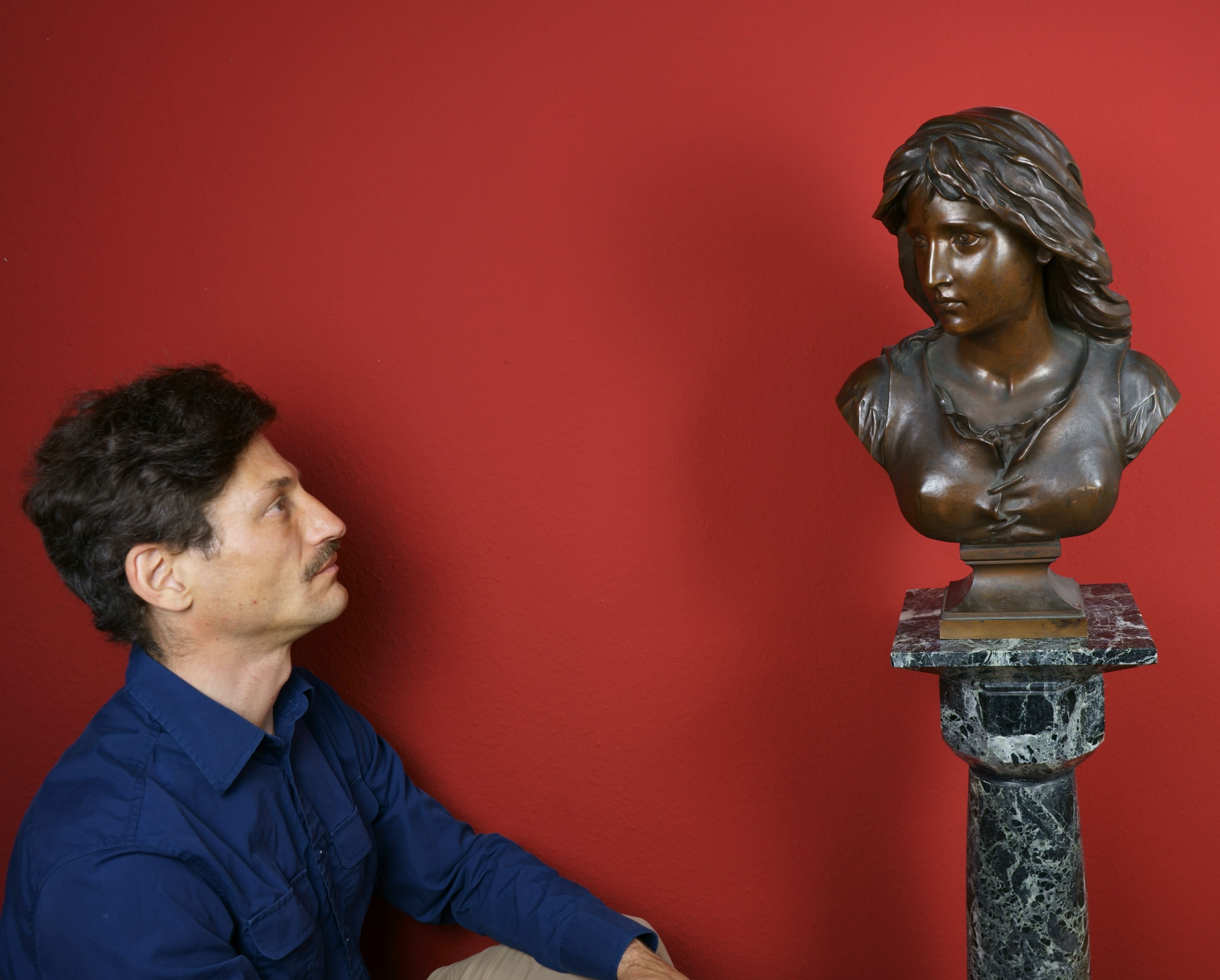
About the Seller
5.0
Vetted Professional Seller
Every seller passes strict standards for authenticity and reliability
Established in 2014
1stDibs seller since 2023
22 sales on 1stDibs
- ShippingRetrieving quote...Shipping from: Berlin, Germany
- Return Policy
More From This Seller
View AllEccentric discharges of a blue-red core / - Energetic traces -
Located in Berlin, DE
Klaus Oldenburg (*1942 Berlin), Eccentric discharges of a blue-red core, around 1975. paint and cast resin on chipboard, 39 x 59 cm (inside dimension),...
Category
1970s Abstract Abstract Paintings
Materials
Resin
$614 Sale Price
20% Off
Tectonic Tension / - Archetypes of Painting -
Located in Berlin, DE
Jürgen Möbius (*1939 Großenhain), Tectonic Tension. Oil on hardboard, 47.5 x 60 cm, 49 x 61.5 cm (frame), signed lower right "Möbius" and dated "[19]81".
- Upper left corner with a small chip, light scratches and a little rubbed in places. Provisional gallery frame with traces of use.
- Archetypes of Painting -
About the artwork
The form structure in front of the eye is overlapped by the frame. Thus, the frame does not open up a space in which something is presented, but rather shows the seemingly arbitrary section of a comprehensive context that cannot be framed as such.
We see forms that stand in a structure of tension with each other, whereby the individual black and brown forms, which continue almost endlessly beyond the frame, already show a tension in themselves, since they are not only forms, but also surfaces - form surfaces, while the light blue surface ground is at the same time forms that appear as surface forms. The formed surfaces and surface forms are nested within each other and form a structure that encompasses all elements.
The angular arrangement of the black and brown shaped surfaces gives the structure a tectonic character. The tension is thus heightened to the point of paradox, since the black shape at the front is overlapped by the brown shape at the bottom in the center of the picture, which would be impossible in real space. It is precisely through this "paradox" that Möbius demonstrates that the paradoxical is reality within painting. It is, so to speak, the most original possibility of painting, which distinguishes it from the other arts. In combination with the tectonic formations, Jürgen Möbius creates an archaic primordial painting, which, however, should not be confused with the autonomous color and form cosmos of Suprematism à la Kasimir Malevich. Instead of homogeneous, perfectly colored forms, here the colors are deliberately applied unevenly, and the light blue is mixed with the brown in a manner determined by the brushstroke. At the edges of the surface forms, the uneven application of paint allows the wood of the unprimed hardboard to show through. In this way, Möbius illustrates that we are dealing with a painting that has been created by an act of painting - an act, however, that takes hold of the original principles of painting and thus realizes painting as such.
About the artist
From 1959 to 1965 Jürgen Möbius studied painting at the University Institute for Art and Work Education in Mainz. He also studied philosophy and art history at the University of Mainz. Afterwards he worked as a freelance artist in Mainz.
At first, Möbius created material reliefs and installations, then, around 1974, he turned increasingly to conceptual art and added cinematic means. During this phase he wrote the manifesto-like essay "Principles of Supranatural Landscape" (1979).
From 1981 on, Möbius concentrated on painting and searched for artistic ways to "treat intellectual and sensual perception equally in the fusion of representational and abstract pictorial elements" (Wolfgang Zemter). He found inspiration on his study trips to Thailand and Sri Lanka.
"The pure painting of Jürgen Möbius flows through us as a timeless expression of memory and energy, ploughing our perception and bringing us the happiness of seeing authentic, immovable form.
- Philippe Büttner
Selection of solo exhibitions
1969 Galerie Würzner, Düsseldorf / Galerie Gurlitt, Mainz
1972 Städtische Galerie, Mainz
1973 Galerie Schloss Ringenberg Rathaus, Kleve
1974 Röderhausmuseum, Wuppertal
1976 Galerie Glasing, Osnabrück / Städtische Galerie, Herne
1977, 1997, 2004 Märkisches Museum, Witten
1979 Studio M, Bamberg / Staatstheater, Darmstadt
1980 Galerie Stolànovà, Wiesbaden / Mittelrheinmuseum, Koblenz
1982 Galerie Dornhöfer, Mainz
1984 Galerie Neumühle, Schlangenbad
1985 Landesmuseum, Mainz / Kunstverein, Ludwigshafen / Nassauischer Kunstverein, Wiesbaden
1986 Museum, Bochum / Galerie der Stadt Iserlohn
1987, 1990 Galerie Klaus Kiefer, Essen
1987, 2000 Galerie Ulrike Buschlinger, Wiesbaden
1988 Kunsthalle Darmstadt
1988, 1992, 1996, 1999 Galerie Leonhard, Basel
1992, 2002 Galerie Zulauf, Freisheim
1994 Galerie Remy, Vallendar
1995 Sendezentrum des Zweiten Deutschen Fernsehens, Mainz
2001 Collegium oecumenicum, Bamberg / MVB Forum für Kultur und Wirtschaft, Mainz
2006 Adam Gallery, London
Selection of group exhibitions
1969 ‘International Graphic Arts’, Galerie Dalléas Bordeaux, Paris
1975 ‘Deutscher Künstler-Bund’, Dortmund
1979 ‘Man and man’s Images’, Märkisches Museum Witten
1980 ‘Love-Dokuments of our Time’, Art Hall Darmstadt and Art Association Hannover
1982 ‘Work - Progress – Position’, Nassau Art Association Wiesbaden
1983 ‘Principle Hope – Utopic Aspects in Art and Culture of the 20th Century’, Museum Bochum
1986 ‘Selfportraits’, Gallery Klaus Kiefer Essen
1987 ‘The Dying and Death’, Gallery Klaus Kiefer Essen
1989 ‘Where are You, Revolution – Freedom, Liberty, Egality, Fraternity to-day’, Museum Bochum 1990 ‘Flight – a Problem within the Memory of Man’, Kunsthalle Darmstadt ‘Art and War 1939 – 89’, House of Cultures Berlin
1991 ‘Material and Form’, Pillnitz Castle Dresden and Pfalz Gallery Kaiserslautern
1995 20 Years Exhibitions, Chrämerhuus Langenthal, Schweiz
1998 ‘Works on Paper’, Klaus Kiefer Gallery Essen
2000 ‘Acquisitions 1900 – 2000’, Mittelrhein-Museum Koblenz
2001 ‘Strange Pictures’, Klaus Kiefer Gallery Essen
2002 ‘10 Years Buschlinger Gallery’, Buschlinger Gallery Wiesbaden
2004 ‘Eternal Space – Pictures and Sculptures’, Dome of Bamberg
2005 Art Fair Chicago, Adam Gallery, London
Selected Bibliography
Mittelrheinisches Landesmuseum (Hrsg.): Jürgen Möbius - Neue Bilder, Mainz 1985.
Kunstverein Darmstadt (Hrsg.): Jürgen Möbius. Bilder 1985 - 1988. Kunsthalle Darmstadt, 26. Juni - 14. August 1988. Red. Dorit Marhenke, Lyrik Marcus Schiltenwolf, Düsseldorf 1988.
Gabriele Prusko (Hrsg.): Jürgen Möbius. Mit Texten von Philippe Büttner und Ralph Mieritz, Basel 1992.
Wolfgang Zemter (Hrsg.): Jürgen Möbius - Aktuelle Arbeiten. Märkisches Museum der Stadt Witten, Bönen 1999.
Wolfgang Zemter (Hrsg.): Jürgen Möbius. Flieger in meinem Zimmer und Beruhigte Zone, Bönen 2004.
Dama Gallery...
Category
1980s Abstract Abstract Paintings
Materials
Oil
$1,323 Sale Price
20% Off
Untitled / - The archaism of nature -
Located in Berlin, DE
Jorge Machold (1940 Chemnitz - 2015 Berlin), Untitled, 1973. Color etching, 41.5 x 29.2 cm (plate size), 49.5 cm x 39.5 cm (sheet size), signed lower right in lead “J.[orge] Machold”...
Category
1970s Abstract Abstract Prints
Materials
Paper
$207 Sale Price
20% Off
Untitled / - Bleeding Picture -
Located in Berlin, DE
Ouhi Cha (*1945 Busan), Untitled, 1988. mixed media, 31.8 cm x 23.3 cm (sheet size), signed “Ouhi Cha” in pencil below and dated “[19]88”.
- in good condition
- Bleeding Picture -...
Category
1980s Abstract Abstract Drawings and Watercolors
Materials
Paper
$359 Sale Price
20% Off
My treasure, my sanctuary / - A Tortured Treasure -
Located in Berlin, DE
Johannes Heisig (*1953 Leipzig), "My treasure, my sanctuary" - To the Christmas Oratorio by Johann Sebastian Bach. Lithograph on strong yellowish laid paper with watermark, 53 x 39.5...
Category
1980s Abstract Expressionist Figurative Prints
Materials
Lithograph
$359 Sale Price
20% Off
Untitled / - Association -
Located in Berlin, DE
Detlef Baltrock (*1954 Stuttgart), Untitled, 1985. Watercolor, 29.5 cm x 21 cm (visible dimensions), 41 cm x 32 cm (frame), signed “Baltrock” lower center and signed “[19]85”, label ...
Category
1980s Abstract Expressionist Abstract Drawings and Watercolors
Materials
Paper
$330 Sale Price
20% Off
You May Also Like
Yellow, Green, and Orange - Abstract Expressionist Composition
Located in Soquel, CA
Yellow, Green, and Orange - Abstract Expressionist Composition in Acrylic on Canvas
Vibrant composition by California artist Charles "Dave" Francis (American, 1951-2018). Layers of ...
Category
Late 20th Century Abstract Expressionist Abstract Paintings
Materials
Canvas, Acrylic, Stretcher Bars
$1,987 Sale Price
25% Off
"Topog #3b" Textured and vivid abstraction in yellow, turquoise, green, orange
By Susan Sharp
Located in Wellesley, MA
"Topog #3b," Oil on Panel, 43 1/2 x 49 1/2 Inches.
Vivid and textured abstraction in yellow, turquoise, orange, green, white and black.
Susan Sharp is an outstanding abstract pain...
Category
2010s Abstract Abstract Paintings
Materials
Mixed Media
Blue, Green, and Yellow Gestural Abstract
By Cora Van
Located in Austin, TX
By Cora Van
39" x 48" x 2.75" Acrylic on Panel
Category
Early 2000s Abstract Abstract Paintings
Materials
Canvas, Acrylic
Slate Blue Abstract with Yellow and Green
By Tom Reno
Located in Austin, TX
Blue, Green, and Yellow Abstract by Tom Reno
28.5" x 22"
Acrylic on Paper
Tom Reno is an abstract artist originally from Southern California who now resides in New Mexico. He is th...
Category
21st Century and Contemporary Abstract Abstract Paintings
Materials
Acrylic, Archival Paper
Intense Primary Color Abstract Acrylic On Canvas
Located in Chicago, IL
Intense and inspired acrylic on canvas in blue, red, yellow and black dated October 13 1978. Comes with a brushed chrome frame and linen mat. The frame measures 30.5"h x24"w x1.25"d.
Category
Vintage 1970s American Paintings
Materials
Acrylic, Canvas
Bright Colored Streak Contemporary Abstract
Located in Houston, TX
Bright sunshine yellow abstract painting with black streaks and blue splatters, by artist Charles Bouille´, 1995. Displayed in a white mat with a gold border and fits a standard-size...
Category
1990s Abstract Abstract Paintings
Materials
Paint, Paper, Watercolor
More Ways To Browse
Jazz Club
Piero Manzoni
Johnny In Paris
Abstract Painting Pink Flowers
Ace Gallery
Acrylic Pour Painting
Burgundy Painting
John Smith Vintage
Abstract Couch
Abstract Korean Painting
Birthday Painting
Graffiti Art On Canvas
Hudson Bay
Modern Triptych Art
Sunflower Abstract
Abstract Sailboat
Airbrush Art
Architectural Blueprints
